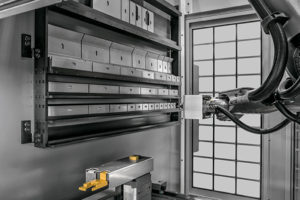When you think about press brake automation you are probably thinking of robot bending operations to increase efficiency and throughput. Press brake bending operations are in fact sequential tasks that are performed by either a human or a robot. Utilizing the latter can be advantageous when large part volumes are produced or in the case of where parts are too large or heavy for one person to handle. In these types of situations, robots assist to eliminate operator fatigue and increase overall safety and ergonomics, not to mention maintaining throughput levels. The beauty of robotic operations lies not only in the consistency, efficiency, safety and throughput levels, but also in the ability of the operators responsible for these systems to multi-task.
Typical press brake operations require that you receive a job sheet or some other method of communications indicating the “next in line” job to be processed on the press brake. Once this is received, the operator must locate the material to be processed and also begin the process of gathering the tools for the job.
Set-up variables
Depending on the length of the parts to be bent and the proximity of the tools to the press brake, set-up time can become quite a variable.
- Having the tooling spread out in different locations or not having them near the brake, adds to the setup time.
- While the operator looks for the flat blanks and the tooling, the machine is not bending.
- If you need to enter information into the job tracking software prior to bending, the machine is not bending.
- While you are placing the tooling in the machine, you cannot do any other task that will contribute to reducing the set-up time of the machine.
That is the situation that a press brake operator must contend with, without the use of automation. Press brake set-up and operations are sequential tasks. There is significant time attributed to the set-up of the press brake that affects the overall time of the job.
Press brake automation is more than just robot press brake tending.
Press brake automation can also include the application of a robot contained within the back side of the press brake housing that automatically sets-up the tools for each job. The bending tools are located on the inside walls of the interior of the press brake and each tool segment can be placed in their required locations by the robot within 10 seconds. When an operator is finished with one job and the next job requires different tooling, the operator just presses a button and the robot begins to replace the existing tooling with the tooling required for the next job.
Once the operator pushes the button they are free to multi-task! While the robot is setting up the tooling, the recently completed job can be logged into the job tracking software, the new bending job can also be entered into the tracking software, blanks and finished parts moved into their proper locations. That’s the set-up time savings as a result of multi-tasking. The additional time savings is attributed to not having to locate and gather tools; and replacing the old tooling back to their respective locations. A robot utilized within the press brake for completing the tooling set-ups can reduce set-up time by 70% or more due to the ability of the operator to multi-task, the consistency of robots, and the immediate proximity of the tooling.
More on the Bystronic Xpert Tool Changer.
By Frank Arteaga, Head of Product Marketing, NAFTA Region
Bystronic Inc., Elgin, IL – Voice.bystronic@bystronic.com

